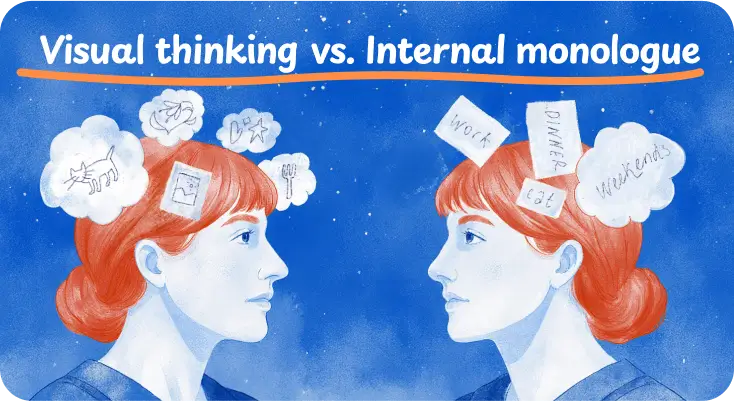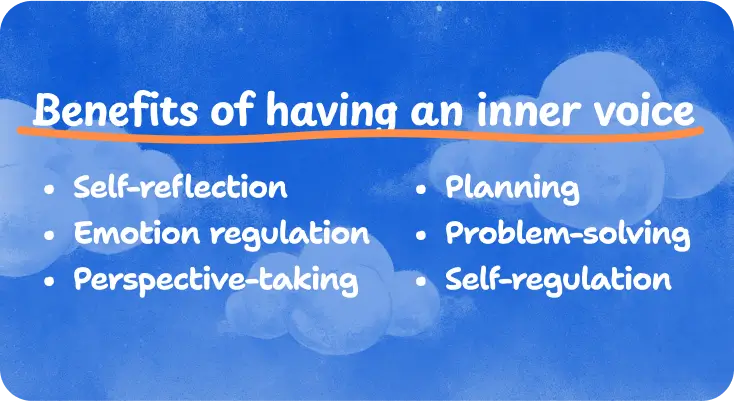Hearing the voice inside your head isn’t always an alarming sign. Whether called “internal dialogue,” “inner monologue,” “self-talk,” etc., it is a normal result of brain mechanisms. It often helps with decision-making, problem-solving, and emotional regulation. However, not all people have internal monologues.
In this article, we’ll find out how your inner voice works, how widespread having inner monologue is, and how people think without it. Even more, we’ll learn more about it’s benefits and drawbacks as well as explore chances to develop inner voice.
Your mental well-being might result from numerous factors and self-critical voice is one of them. Find out how to take care of yourself with more supportive thoughts by taking a free 5-minute test.
What is an inner monologue?
According to the article shared by the American Psychological Association, inner speech can be defined as the subjective experience of language in the absence of overt and audible articulation. [1] To put it simply, this is the voice you “hear” in your head when you think in words without speaking them out loud.
Scientists believe that inner speech is like a mental echo of your own voice. It works similarly to corollary discharge (a brain signal that predicts the sound of our voice to separate self-made sounds from external ones). This explains why inner speech can actually quiet down outside sounds, meaning it’s not just “silent talk” but a real sensory process in the brain. [2]
Theories of why people have inner speech
Researchers explain inner dialogue in different ways. Some see it as a tool for self-regulation that helps us manage our behavior (Vygotsky’s theory). Others consider it a part of our working memory that allows us to store verbal information (the cognitive model). Let’s look at both theories in detail.
Vygotsky’s theory
- Vygotsky argued that inner speech comes from social interactions with caregivers when we develop our language skills. Over time, children’s external dialogues turn into talking to themselves and finally transform into inner speech (silent thought).
- Its main role is self-regulation, which helps people guide their own behavior, plan actions, and solve problems without relying on others.
Working memory model
- From a cognitive perspective, inner speech exists because of the phonological loop, a part of working memory that temporarily stores and rehearses verbal information. This explains why we silently repeat phone numbers, shopping lists, or directions in our heads — we’re using inner speech to keep information “online.”
- It also supports language learning in children, since repeating and rehearsing sounds strengthens memory and understanding.
3 dimensions of inner monologue
While internal monologue might seem the same for everyone who experiences it, this isn’t the case. People process their thoughts and “inner words” in different ways. To explain this, scientists developed the ConDialInt model — a neurocognitive framework that describes inner speech along three key dimensions. [3]
- Condensation means that inner speech may be detailed and consist of full sentences or be very compact, like hearing only separate words.
- Dialogality means that while some people “hear” internal monologue (only your voice), others might have inner dialogues (especially when imagining yourself talking to someone).
- Intentionality means that your self-talk might appear purposeful or just pop up on its own when your mind is wandering.
If you want to analyze how significantly inner monologue influences your life, try Breeze’s mood tracker. It allows you to notice your mood shifts depending on the tone of your inner voice and spot patterns that affect your well-being.
Does everyone have an inner monologue?
According to Russell Hurlburt’s research, only about 30-50% of people live with an internal monologue. [4] Still, it is tough to say whether this percentage is completely correct because self-talk is really tough to study. Scientists can’t see what someone is thinking about and how they do it. But despite the challenge, some researchers attempted a systematic approach and came up with a few ways to analyze inner monologues.
Descriptive Experience Sampling (DES) is the method Russell Hurlburt, Ph.D., a professor of psychology at the University of Nevada, Las Vegas, used to provide the estimated percentage mentioned above. It means that participants report about their behaviors, thoughts, and feelings at random times throughout the day.
Nevertheless, other methods, such as keeping diaries, conducting interviews, and conducting self-report surveys, help researchers gather more detailed information about the frequency, form, and quality of inner speech in different people.
For instance, self-report surveys based on the Varieties of Inner Speech Questionnaire (VISQ) have found that different people experience five main types of inner speech:
- Dialogic — inner speech that feels like a conversation with yourself that involves questions and answers.
- Evaluative/critical — self-talk that judges your actions, thoughts, or feelings.
- Other people — inner monologue that uses the voices of others in your mind.
- Condensed — short internal monologue that skips full sentences and details.
- Positive/regulatory — supportive self-talk that helps regulate emotions and behavior.
Participants reported the most evaluative inner speech (self-criticism or reflection), then dialogic, condensed, and positive. The “other people” inner monologue was the least common. [5]
This research shows that inner speech serves different purposes for everyone. Most people use it to evaluate themselves and analyze their behavior. However, it’s important to avoid overthinking, as internal monologue can be rather harsh and critical.
How it feels to not have an inner voice
Around 50-70% of people don’t have internal voices. It doesn’t feel like emptiness; they rather replace “words” with other forms of thinking, so thoughts don’t take the form of a “voice” in their heads. Also, some people might experience inner talk from time to time, but it might be more brief and less structured than a constant internal monologue.
“Could you please explain whether living with an internal monologue helps a person in the therapeutic process or vice versa?” Abigail Fernald, LCSW, answers, “Having an internal monologue can be helpful in the therapeutic process, but it’s not a requirement for meaningful insight or healing. Clients with an active inner dialogue may find it easier to identify and articulate their thoughts, which can support cognitive restructuring, self-reflection, and mindfulness practices. However, for individuals who do not experience a verbal inner monologue, such as those who think in images, sensations, or abstract concepts, therapy can be just as effective when clinicians adapt their approach. It’s important for therapists to explore and honor each client’s unique cognitive style rather than assume one “right” way to think.”
How do people without an inner monologue think?
Inner experiences might be processed through visual imagery, sensory experiences, abstract thoughts, and other unique ways of thinking. Here we’ll take a closer look at the most common ways people might think, except for internal monologue.
Visual imagery
Inner seeing means that a person processes information through images. For instance, when someone thinks about giving a work presentation, they imagine standing in front of their colleagues and giving a speech.
If you’ve seen Sherlock Holmes (with Robert Downey Jr.), you might remember that Holmes often runs entire scenarios in his head. The character pictures every move of a fight or outcome of a plan like a film playing in his mind. This is a perfect example of visual imagery.

Sensory experiences and feelings
This type can also be called “sensory awareness,” a way of thinking in which a person perceives ideas through sensations, emotions, or physical states. For example, when you imagine yourself going skiing, you might feel how cold the weather is going to be, how your body will move as you balance on the skis, and even the rush of excitement or fear in your stomach.
Abstract thoughts
There are also people who have unsymbolized thinking and perceive and process information conceptually without words or images. Their thinking is built around patterns, connections, or logical structures. For example, when planning a project, they analyze the strategy of how different steps fit together and focus on the overall picture.
Other ways of processing information
Finally, there are people who can think in symbols, colors, or patterns, linking information nonverbally. This process can feel like collecting pieces of a puzzle, and the meaning comes to them all at once, similarly to a sudden flash of understanding.
Not only our way of thinking but also our emotional intelligence defines how we approach the world and the people around us. Take a quick test and gain personalized insights on how to find a common language with everyone.
Inner monologue and mental health
Living with an internal monologue might have benefits and drawbacks. Let’s review all the aspects and find ways to make your inner speaking work for you.
Benefits of having an inner voice
- Planning. Your inner voice helps you stay organized, set goals, and plan ahead by “talking yourself through” what needs to be done and adding structure.
- Problem-solving means that you can complete everyday tasks step-by-step and weigh options, consider consequences, and mentally test solutions before acting.
- Self-regulation. Private speech allows us to remember specific personal standards and weigh options rather than make impulsive decisions.
- Self-reflection means analyzing one’s behavior, learning from past experiences, and seeing one’s thoughts from a different perspective.
- Emotion regulation helps you support yourself in stressful situations, manage your feelings when they become overwhelming, and calm yourself down when something happens.
- Perspective-taking. Internal dialogue allows you to imagine others’ thoughts and viewpoints. This can improve empathy and social understanding.

Downsides of inner monologue
- Overthinking. Dwelling too much on your thoughts can make you feel frustrated even about typical real-life situations.
- Self-criticism can appear when your inner voice is too harsh and makes you focus on negative statements about yourself and repeat them in your head instantly. This inner critic often forms as a protective mechanism in response to past experiences or adverse environments.
- Distraction. Sometimes, people concentrate on inner conversations so much that they miss important information that others say. It might also be difficult to stay mindful and focus on the present moment.
- Decision paralysis might result from people’s overanalyzing everything in their heads and feeling overwhelmed.
- Perfectionism. If you constantly “hear” an overly critical internal monologue, it can make you feel frustrated and push unrealistic standards, making your life much more challenging. This could have roots in trauma, developmental neglect, or attachment wounds.
- Mental fatigue. Finally, persistent inner dialogue can become draining, especially if it is shaped by anxiety, trauma, or self-criticism.
Do you live with an inner monologue?
When your inner coach becomes your inner critic
Your inner monologue can manifest in different ways. It might turn into a supportive coach who helps you reach your goals, or into a toxic critic who makes you think, “Why am I so insecure?” Take a look at the table and assess which voice speaks louder in your daily life.
| Inner critic | Inner coach |
| Harsh and judgmental tone | Supportive and encouraging tone |
| Focuses on mistakes, flaws, and failures | Helps with growth and learning |
| Can cause anxiety, guilt, and low self-esteem | Makes you feel calm, empowered, and optimistic |
| Persistent and intrusive | Can be used mindfully and intentionally |
Can you develop or change your inner monologue?
Yes, developing or changing your inner monologue is possible. Finding your own voice may take some time, but here are some practices that may be helpful.
- Slow down regularly. Schedule a few times throughout the day when you can focus on your thoughts instead of doing something. Reflect on what happens in a form of conversation. Make sure that the speech in your head is supportive rather that critical and if it starts to become negative, gently shift your mind.
- Engage in journaling. Writing down what you’re grateful for and what makes you feel stressed can change the way you approach the world. Try journaling from Breeze and you’ll be able to reflect on the reality more clearly with the right prompts.
- Practice active listening. When you learn to process hearing speech, it gets easier to you to handle conversations in your head and direct them in the right way. Don’t hesitate to ask questions, as curiosity allows you to guide dialogues (both internal and external) more effctively.
Expert Insight
“Shifting from self-critical self-talk to a more supportive internal dialogue is a powerful part of healing, especially for those who grew up in invalidating or high-pressure environments. The first step is building awareness through learning to notice when your inner critic is active and identifying the tone, language, and triggers. From there, you can begin to challenge those thoughts with curiosity rather than judgment, asking, “Whose voice is this?” or “Is this belief still serving me?” Practicing self-compassion exercises, such as speaking to yourself the way you would to a struggling friend, can also help rewire those patterns. Techniques like thought reframing, journaling, inner child work, and even naming your inner critic (to create distance from it) are often used in therapy. Over time, and often with support, the inner voice can shift from critical to caring, one that encourages growth without shame.”
Abigail Fernald
Mental health professional
Final Thoughts
Now you know what internal monologue is and how it influences your life, as well as understand the ways most people think. If you want your inner voice stay positive and encouraging, we highly recommend you to engage in self-discovery and take care about your physical and mental well-being. Try Breeze to track your thoughts, reflect on your emotions, and find new ways you can reach a healthier, more supportive mindset.
Frequently asked questions
Is it normal that not everyone has an inner monologue?
Yes, it’s completely normal not to have an internal monologue. Each person’s way of processing information is unique: some rely more on verbal thought, while others engage visual pathways like the dorsal stream, and some rely on abstract concepts.
Do people with ADHD have more or less internal monologue?
There are no direct studies that analyze the link between ADHD and inner monologue. However, researchers have found that children with ADHD at later ages (7–11) tend to use externalised private speech on tasks more often than neurotypical children. [6]
What about autistic individuals and inner speech?
People with Autism Spectrum Disorder (ASD) may experience inner monologue differently. Some use it less or in a delayed way, especially if they had language development challenges early on. Others describe thinking more in pictures, patterns, or sensory impressions instead of words.
Do most people with high IQs have inner monologues?
There’s no scientific evidence that high IQ is associated with internal monologue. Instead, we can suggest that it’s more about personality and a unique way of thinking and perceiving the world.
How do I tell if I have an inner monologue?
Inner monologue feels like a voice in your head that “speaks” when you’re silent. To understand whether you have one, try noticing “conversations” inside as you create a to-do list or solve problems. Think about how you analyze past experiences and whether they form words, sentences, pictures, or something completely different.
If you find it challenging to handle your inner monologue, experience excessive self-criticism, decision paralysis, or mental fatigue, it might be helpful to reach out to a mental health professional. A licensed therapist can help you develop healthier coping strategies and find ways to quiet or reframe your inner dialogue.
Sources
- Alderson-Day B, Fernyhough C. “Inner Speech: Development, Cognitive Functions, Phenomenology, and Neurobiology.” Psychol Bull. 2015
- Scott M. “Corollary discharge provides the sensory content of inner speech.” Psychol Sci. 2013
- Grandchamp Romain, Rapin Lucile, Perrone-Bertolotti Marcela, Pichat Cédric, Haldin Célise, Cousin Emilie, Lachaux Jean-Philippe, Dohen Marion, Perrier Pascal, Garnier Maëva, Baciu Monica, Lœvenbruck Hélène. “The ConDialInt Model: Condensation, Dialogality, and Intentionality Dimensions of Inner Speech Within a Hierarchical Predictive Control Framework.” Frontiers in Psychology. 2019
- Russell T. Hurlburt, Ben Alderson-Day, Simone Kühn, Charles Fernyhough. “Exploring the Ecological Validity of Thinking on Demand: Neural Correlates of Elicited vs. Spontaneously Occurring Inner Speech.” 2016
- Alderson-Day B, Mitrenga K, Wilkinson S, McCarthy-Jones S, Fernyhough C. “The varieties of inner speech questionnaire – Revised (VISQ-R): Replicating and refining links between inner speech and psychopathology.” Conscious Cogn. 2018
- Ben Alderson-Day, Amy Pearson. “What can neurodiversity tell us about inner speech, and vice versa? A theoretical perspective.” Cortex. 2023
Disclaimer
This article is for general informative and self-discovery purposes only. It should not replace expert guidance from professionals.
Any action you take in response to the information in this article, whether directly or indirectly, is solely your responsibility and is done at your own risk. Breeze content team and its mental health experts disclaim any liability, loss, or risk, personal, professional, or otherwise, which may result from the use and/or application of any content.
Always consult your doctor or other certified health practitioner with any medical questions or concerns
Breeze articles exclusively cite trusted sources, such as academic research institutions and medical associations, including research and studies from PubMed, ResearchGate, or similar databases. Examine our subject-matter editors and editorial process to see how we verify facts and maintain the accuracy, reliability, and trustworthiness of our material.
Was this article helpful?





